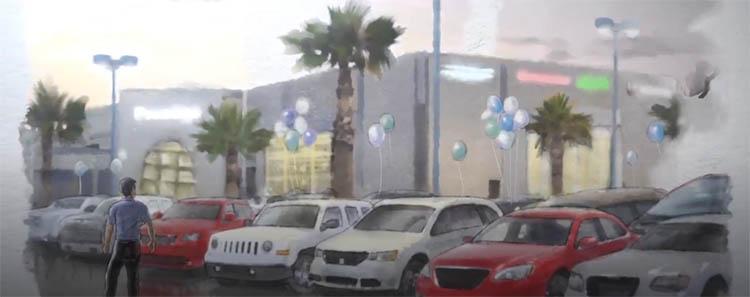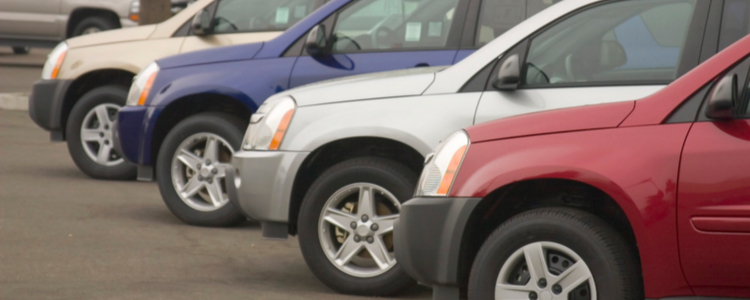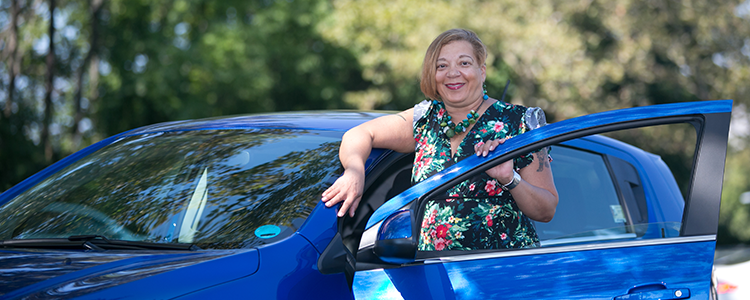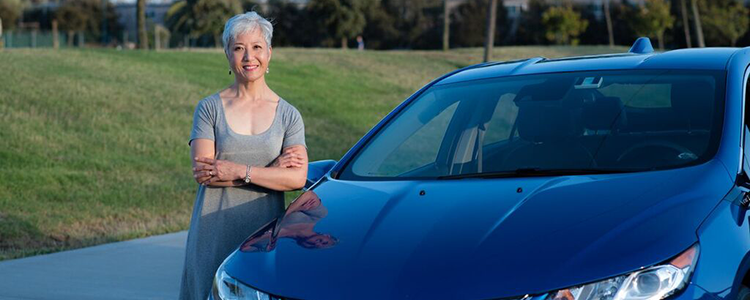Understanding Auto Loans
When purchasing your next car, it's important to understand the entire cost and duration of your loan and to get all the facts, upfront, so you can make the decision that best fits your life.
Ready to Learn More?
Watch our Understanding Auto Loans module. It's quick and easy. Simply click the yellow button at the bottom of this page. You'll then see the "Understanding Auto Loans" page. To start watching, simply click the orange "play" button. This video will include helpful information about auto loans, such as:
- How are auto loans financed?
- How long are the terms of the loans?
- What's the difference between a fixed rate loan and a variable interest rate?
Tips
Once you've started the module, you can see captions, adjust volume and pause the module by using the controls at the top right of the screen. You can also select the transcript button to see all of the content from the module.


So, you’re ready to buy a new car. But, you have to figure out the best loan for your needs. Don't worry, we've partnered with Everfi, Inc. to help you understand the process!
Buyer Beware: How to Avoid Buying a Flood Damaged Vehicle
With around 5 million vehicles in the wake of Florence, flood damaged vehicles could run in the thousands. “While, hopefully, these vehicles will have their titles marked flood damaged and go to salvage yards, many will likely re-enter the market as used cars,” said Jack Gillis, the Consumer Federation of America’s Executive Director and author of The Car Book. “Because of the computerization, electronics and sophisticated safety technology in today’s vehicles, it’s critical that you avoid getting stuck with one of these lemons.”
“Looks can be deceiving—with a nice clean up, these water infested vehicles, may actually look pretty good—which means knowing how to identify a flooded vehicle is critical. When it comes to buying a car, three out of four of us buy used. So there’s a big incentive for disreputable sellers to move flood damaged vehicles north hoping to sell them to unsuspecting buyers,” said Gillis. “While luckily less cars have been flooded compared to Harvey and Irma, flooded cars remain a significant risk to unsuspecting consumers. By following these tips, consumers can protect themselves from purchasing a vehicle which can put themselves and their families at risk,” Gillis continued.
Ten Tips for Avoiding a Flood Damaged Vehicle
- Check the VIN (Vehicle Identification Number) which is located on the driver’s side dashboard, visible through the windshield, with the National Motor Vehicle Title Information System established by the U.S. Department of Justice. You’ll have to pay a small fee for the information, but it’s the most comprehensive data base. You can also check with the National Insurance Crime Bureau (NICB) or CarFax (both currently offering free flood history information). Even if the database has no flood information, beware, as fraudsters have ways of getting around VIN registration information or it simply wasn’t reported.
- Use your nose. Beware if the vehicle smells musty or damp or if you smell some kind of air freshener. Close up the windows and run the air conditioner and check for a moldy smell.
- Look for dirt, mud and water stains. Check the carpets, seat upholstery, cloth lining inside the roof, if you see any dirt or mud stains, beware. Feel under the dashboard for dirt or moisture and look in the glove boxes, ashtray, and various other compartments for moisture or stains. If you see straight stain line either on the inside of the door panel, engine compartment or trunk—watch out, that’s probably how high the water went in the vehicle. Tip: If the carpeting, seat coverings or headliner seem too new for the vehicle, that’s a sign that they may have been replaced due to flood damage.
- Listen for crunch. Pull the seats forward and back and try all of the safety belts. If you’re looking at an SUV with folding seats, try folding them all. Listen for the ‘crunchy’ sound of sand or dirt in the mechanisms or less than smooth operation.
- Check the spare tire (or inflator) area. Look for mud, sand or stains on the spare tire and jack equipment and the well under the spare tire. Check under the trunk carpet for a rigid board and look to see if it is stained or has water damage.
- Power up. Be sure to try all the power options including windows, locks, seats, moon roof, automatic doors, wipers, window washers, lights, AC system, etc. If any don’t work, sound funny, or operate erratically, beware. And don’t forget the sound system. Try out the radio, CD player and Bluetooth connectivity. Adjust the speakers front and back and side to side to listen for any crackling or speaker failure.
- Check for rust or corrosion. Look around the doors, in the wheel wells, under the seats, under the hood and trunk and inside the engine compartment.
- Look under the hood. Look at the air filter. It’s often easy to check and will show signs of water damage. Check the oil and transmission fluid. If it looks milky or has beads of water, watch out.
- Take a test drive and listen for unusual engine or transmission sounds or erratic shifting and acceleration. Set the cruise control to see if it is working properly.
- Check out the head and tail lights; look closely to see if there is any water or fogging inside. Same with the dashboard—are any of the gauges foggy or containing moisture droplets.
Contact: Jack Gillis, 202-939-1018
Union members buying a preowned vehicle are eligible for a free CarFax Reports on most vehicles.


With Florence flooding thousands of vehicles, there’s a good chance unscrupulous sellers will try and sell these potentially dangerous vehicles.
New Car Brings Improved Commute for OPEIU Member
Boston has a reputation for having the nation’s worst gridlock. Still, each day, Sharon Matthews, who is a member of Office and Professional Employees International Union (OPEIU) Local 6, makes the commute from her home in Cambridge, Massachusetts to her job at the Roxbury Division of the Boston Municipal Court.
One day, Matthews’ trusty car’s check engine light illuminated. She faced the all-too-common conundrum: to repair or to replace?
“It required major exhaust and emissions systems work,” recounts Matthews. “That means it was going to be very expensive.”
Then, she remembered getting a piece of mail that highlighted the Union Plus Auto Buying service. Matthews logged onto the Union Plus website and began seriously considering a new car purchase.
The Union Plus Auto Buying Service partners with price-comparison service TrueCar to let union members research pre-screened and certified dealers, see prices online, and get additional dealer discounts, in addition to offering rebates for union-made cars.
“I found a union-made car and a car dealership that was union friendly,” Matthews recalls. “They gave me a discount on the spot. I got the cutest Chevrolet Sonic in blue. It’s easy to park on the city streets and it gets great mileage. I love driving it to work.”
The vehicle Matthews purchased made her eligible for the Union Plus union-made green car** rebate that totals $200. Union Plus automatically sends rebate checks to members who purchase qualifying union-made vehicles, with no additional paperwork from the member.
“The savings were great,” says Matthews happily. “What I didn’t expect was the rebate I received in the mail. I was in total shock.
“I can’t say enough good things about Union Plus,” she enthuses. “They save union members so much money and their benefits are great.”

* Between 7/1/17 and 9/30/17, the average estimated savings off MSRP presented by TrueCar Certified Dealers to users of TrueCar powered websites, based on users who configured virtual vehicles and who TrueCar identified as purchasing a new vehicle of the same make and model listed on the certificate from a Certified Dealer as of 10/31/2016, was $3,383. Your actual savings may vary based on multiple factors including the vehicle you select, region, dealer, and applicable vehicle specific manufacturer incentives which are subject to change. The Manufacturer's Suggested Retail Price ("MSRP") is determined by the manufacturer, and may not reflect the price at which vehicles are generally sold in the dealer's trade area as not all vehicles are sold at MSRP. Each dealer sets its own pricing. Your actual purchase price is negotiated between you and the dealer. TrueCar does not sell or lease motor vehicles.
**EPA Green Car Make and Models Include:
- Chevrolet — Bolt, Volt, Cruze***, and Sonic***
- Chrysler — Pacifica Hybrid
- Ford — Focus
*** Check the VIN number of these vehicles. Some are assembled in Mexico and begin with the number 3. These are not eligible for rebates.

Sharon Matthews, who is a member of Office and Professional Employees International Union (OPEIU) used the Union Plus Auto Buying service to find and purchase a union-made vehicle. Because she bought a union-made vehicle, she was eligible for additional savings through Union Plus.
Rolling Down the Freeway LA Leader Uses Union Plus to Get New Wheels
Working in the entertainment industry in Los Angeles requires a lot of support and a working car. That’s why Screen Actors Guild-American Federation of Television and Radio Artists (SAG-AFTRA) administrator Grace Danziger was so excited to get help from Union Plus with her latest car purchase when the lease on her old car was ending.
“I have been receiving Union Plus benefit emails for quite some time,” Danziger recalls. “The auto buying program caught my eye.”
“Choosing a plug-in hybrid was important for environmental and economic concerns,” Danziger notes, adding that she and her husband Marc wanted to find the best deal possible.
That is why they decided to take advantage of the Union Plus partnership with the price-comparison service TrueCar. The Union Plus Auto Buying Service lets members research pre-screened and certified dealers, see prices online, and get additional dealer discounts, in addition to offering rebates for union-made cars.
In addition to enjoying an easy search and application process, Danziger says that she felt personal support from the Union Plus partnership as well.
“I feel like we were taken extra care of,” she says, noting that the dealer they bought from was affiliated with Union Plus. “They had great customer service and they made buying our car a worry-free experience.”
To top it all off, the Union Plus service added a $200 rebate to the deal since the Danzigers bought a new union-made car and a hybrid at that.
Danziger says that the entire process was “so easy that it felt like we received a gift!”
"Union Plus offers so many ways workers can save money on things they are already doing like buying cars and taking vacations,” Danziger concludes. “All union members and staffers should take advantage of Union Plus programs!"
To learn more about the Union Plus Auto Buying Service, visit unionplus.org/autobuying.

* Between 7/1/17 and 9/30/17, the average estimated savings off MSRP presented by TrueCar Certified Dealers to users of TrueCar powered websites, based on users who configured virtual vehicles and who TrueCar identified as purchasing a new vehicle of the same make and model listed on the certificate from a Certified Dealer as of 10/31/2016, was $3,383. Your actual savings may vary based on multiple factors including the vehicle you select, region, dealer, and applicable vehicle specific manufacturer incentives which are subject to change. The Manufacturer's Suggested Retail Price ("MSRP") is determined by the manufacturer, and may not reflect the price at which vehicles are generally sold in the dealer's trade area as not all vehicles are sold at MSRP. Each dealer sets its own pricing. Your actual purchase price is negotiated between you and the dealer. TrueCar does not sell or lease motor vehicles.
**EPA Green Car Make and Models Include:
- Chevrolet — Bolt, Volt, Cruze***, and Sonic***
- Chrysler — Pacifica Hybrid
- Ford — Focus
***Models are made in both the US and Mexico. Vehicles with VIN beginning with the number 3 are ineligible.

SAG-AFTRA administrator Grace Danziger wanted to purchase a plug-in hybrid for the best price possible. She turned to the Union Plus Auto Buying Service and was able to get a great deal on her new hybrid.
Get Exclusive Benefits and Savings with Union Plus Auto Insurance
*Savings based on our 2018 countrywide research of new call center customers’ annual average savings in 2017. Statistics do not reflect sales of the product sold on MetLife Auto & Home MyDirect®.
**Delay is not automatic. Certain restrictions apply. Policyholder must request delay of payment by calling 1-800-GETMET8. Delayed premium payment is expected when hold is lifted. 1 See policy for restrictions. Not available in all states. 2 Not available in all states. In NY, drivers must pay a state-required minimum deductible before using this benefit. MetLife Auto & Home is a brand of Metropolitan Property and Casualty Insurance Company and its affiliates: Economy Preferred Insurance Company, Metropolitan Casualty Insurance Company, Metropolitan Direct Property and Casualty Insurance Company (CA Certified of Authority: 6730; Warwick, RI) Metropolitan General Insurance Company, Metropolitan Group Property and Casualty Insurance Company (CA COA: 6393; Warwick, RI), and Metropolitan Lloyds Insurance Company of Texas, all with administrative home offices in Warwick, RI. Coverage, rates, discounts, and policy features vary by state and product, and are available in most states to those who qualify. Met P&C®, MetCasSM, and MetGenSM, are licensed in MN.
© 2018 MetLife Auto & Home
L0118501934[exp1220][All States][DC]
When you’re ready to protect your vehicle from fender to bumper, look to Union Plus Auto Insurance provided through MetLife Auto & Home®. Check out this video to see what the program has to offer you.
How to Drive on Icy Roads
Icy roads are one of winter’s biggest dangers. Fortunately, you can take simple steps to keep you safer.
Change Your Tires
If cold, icy winters are common in your area, swap your regular tires for snow tires to gain more control. Snow tires have more contact edges than normal tires, allowing them to grip the road better. Also, the rubber on snow tires stays pliable in low temperatures, which helps provide better traction.
Drive Cautiously
- Think gradual. Quick movements, such as fast acceleration or sudden turns, have little effect on icy roads—you just spin your wheels or continue in the same direction. Slow your motions so your vehicle has time to respond. Brake gradually, too: Slamming on the brakes, even antilock brakes, can cause your car to slide. To give yourself enough time to brake, allow up to 10 times the normal distance between your car and the car ahead of you.
- Slow Down. Remember that posted speed limits are for ideal driving conditions. If the roads are icy, reduce your speed to reduce the risk of getting in an accident.
- Correction. If your car starts to skid or slide, take your foot off the gas. Slowly turn the wheel in the direction you want the car to travel. If your vehicle has antilock brakes, apply firm pressure until you regain control. You can steer during this maneuver. As your car spins, work to regain a neutral steering position. You have more control when your tires face the same direction.
Know the Roads
To stay ahead of icy roads, know when and where ice forms. Any winter precipitation can cause ice, as can sudden temperature changes. “Black ice” (a thin, almost invisible coat) is most likely to form on intersections, bridges, overpasses, underpasses and ramps. For more about dealing with black ice, follow this advice from MetLife Auto & Home.
Be Aware of Other Drivers
Driving slowly offers some protection from other drivers, but be sure to keep an eye on the cars ahead of and behind you. If you see brake lights ahead, slow down. If a driver follows closely behind your vehicle, keep a slow pace to force him or her to do the same.
These tips were brought to you by the Union Plus Auto and Home Insurance program. Drivers saved an average of $586* a year on their auto insurance when switching to MetLife Auto & Home®.
Take advantage of the Union Plus Auto and Home Insurance Program by calling 855-666-5797 today. Remember to mention your discount code: DJ7.

*Savings based on our 2018 countrywide research of new call center customers’ annual average savings in 2017. Statistics do not reflect sales of the product sold on MetLife Auto & Home MyDirectSM.
Group Discounts are filed on an individual basis in MA and may not be available as part of MetLife Auto & Home's benefit offering.
MetLife Auto & Home is a brand of Metropolitan Property and Casualty Insurance Company and its affiliates: Economy Preferred Insurance Company, Metropolitan Casualty Insurance Company, Metropolitan Direct Property and Casualty Insurance Company, Metropolitan General Insurance Company, Metropolitan Group Property and Casualty Insurance Company and Metropolitan Lloyds Insurance Company of Texas, all with administrative home offices in Warwick, RI. Coverage, rates and discounts and policy features vary by state and product, and are available in most states to those who qualify. Met P&C®, MetCasSM and MetGenSM are licensed in the state of MN.
© 2018 MetLife Auto & Home
L1016481659[exp0919][All States][DC]

Slick streets? Take precautions! These tips can help improve your safety.
Stop These Top Five Distracting Driving Habits
Consider these five distracting driving habits and how to change them:
- Eating or drinking
Hot coffee spills, greasy hands or stray crumbs could distract you from the road. Eat before you get behind the wheel or after you’ve reached your destination. If you need a snack now, find some place off the road to stop.
- Making hands-free calls
You may not take your hands off the wheel, but calls can take your mind off the road. Turn off your phone’s Bluetooth capabilities before you drive off, and silence your phone to help prevent temptation. If you really need to make a call, safely pull over to talk.
- Messing with dials or controls
Adjusting volume, looking for a radio station, plugging in GPS directions or turning up the heat diverts your eyes from the road. Take care of all of the above before shifting into gear. If you must make adjustments, wait until you come to a complete stop at a stoplight, pull over safely, or ask your front-seat passenger to handle them.
- Paying attention to other passengers
Young children and infants can be up to eight times more distracting than adult passengers, according to the AAA Foundation for Traffic Safety. Make sure your little ones have something to occupy them. Or stop the car and pull over safely before investigating the cause of screaming or crying.
- Applying makeup or shaving
The vanity mirror blocks your eyes from the road. Give yourself enough time before leaving home to finish getting ready.
As a union member, you have access to auto insurance with MetLife ChoiceSM allowing you to quickly and easily compare auto coverage from top insurance companies.
Call 855-666-5797 and mention your discount code: DJ7.


It's harmless to sip your coffee on the way to work, right? Maybe not so much!
Some of the things you do regularly behind the wheel have become so ordinary you might not realize you’re driving distracted and may be at risk of a car accident. But if your eyes, hands or mind are focused on anything but driving, you fit the National Highway Traffic Safety Administration’s definition of a distracted driver.
Looking to Buy a Car? Four Things to Keep in Mind
Here are four things to keep in mind when you’re considering an offer in a car ad:
- The fine print is important. Read the entire ad. The small print shouldn’t contradict the big print.
- Compare offers from multiple dealers. If you don’t understand what an ad is offering, you can look for an offer from another dealer.
- Speak Spanish? All of the ad should be in the same language. A company should give you all the important information in the same language, so you can understand the entire offer. Be skeptical if the ad you see is in Spanish, but parts of it are in English. The FTC recently announced a case against a dealership that advertised attractive terms in Spanish, but had other important information in English.
- Asking questions is important. When you visit the dealer, you should ask many questions. If you decide to buy, be clear on the terms you’re agreeing to before signing anything.
When you see a car ad, keep a critical eye. If the ad offers, for example, low monthly payments or 0% rates, and if the fine print at the bottom of the ad contradicts the offers in large print on the same ad, the ad may not be telling the whole story.
To find the best car deal, it’s a good idea to shop around and compare offers from different dealers. Also, consider various financing sources like banks or credit unions. Learn more about buying and owning a car at www.FTC.gov/cars.


Buying a car can be overwhelming. There are many things to consider, including your budget, your needs and preferences, and the inventory available at the time. And you see car ads when searching online, when watching TV, while reading the newspaper or listening to the radio. So how do you know those offers are the real deal?
What to Keep in the Trunk This Winter
For small vehicle repairs:
- Canned, compressed air with tire sealant
- Spare tire, vehicle jack and lug wrench
- Tarp to kneel on
- Portable battery charger and booster cables
- Basic tools: a set of socket and open-end wrenches, a multi-tip screwdriver, and pliers
- Empty gas can
- Shovel
- Chains, rope or tow strap
- Road salt, sand or cat litter to help with wheel traction
For signaling help:
- Cell phone and charger
- Emergency flares
- Brightly colored flag or help signs
- Reflective hazard triangles
- Whistle
For staying warm:
- Extra winter clothing: boots, hats, coats and mittens
- Blankets: wool or fleece maintain insulation even when wet
- Sleeping bags
- Chemical heat packs
- Waterproof matches and candles
- Fire extinguisher
For your health and safety:
- Small water bottles
- Nonperishable, high-energy foods: protein bars, raisins, nuts, etc.
- Flashlights with extra batteries
- Basic sanitation supplies: toilet paper, baby wipes, plastic bags, etc.
- Multi-tool pocket knife
- First-aid kit
- Extra prescription medications for serious conditions such as heart disease, diabetes, asthma and allergies
As you stock up, familiarize yourself with each item so you know how to use it. Also keep your safety kit up to date in your car throughout the season — especially before long trips. Make sure everything works, and replace broken or expired items.
These tips were brought to you by the Union Plus Auto and Home Insurance program. Drivers saved an average of $536 a year on their auto insurance when switching to MetLife Auto & Home® .
Take advantage of the Union Plus Auto and Home Insurance Program by calling 855-666-5797 today! REMEMBER to mention your discount code: DJ7.

L1016481659[exp0919][All States][DC]

Be prepared for any road emergency with these supplies.
Low temperatures and winter weather can create hazardous road conditions. Stay ready for whatever comes with this emergency kit:
How to Protect Yourself When Buying a Used Car in Seven Easy Steps
Perhaps even worse is buying a used car with hidden damage from an accident, flood, or other incident that might affect safety and performance. Shoppers don't want to pay thousands of dollars for someone else’s problems.
Consumer Reports' Auto and Finance experts have come up with these savvy tips to ensure that you're getting a good used car. Remember that when buying a new or used car from a dealership, you should carefully double-check the agreement and all the numbers.
-
Don't Skip the Test-Drive
Why you shouldn’t: This is where you first determine if the vehicle is worth your consideration.
What you should do: Note unusual squeaks and rattles, or any items that need to be repaired. A car that pulls to one side might be showing signs of previous damage. Paint overspray on the backs of body panels and doorjambs can signal body work from an accident. The smell of mildew or mold could indicate water damage, which you definitely want to avoid. CR chief mechanic John Ibbotson says to avoid vehicles with signs of deep water exposure. “Even if a vehicle looks acceptable, and may be working when you inspect it,” Ibbotson says, “water damage could lead to many electrical problems down the road.”
-
Check the Car's Title
Why you should: This will help you avoid surprises that could pop up when you go to register the car.
What you should do: First, make sure the seller has the actual title for the vehicle on hand. Examine the title document for signs that the vehicle has been wrecked, repurchased under a state lemon-law program, suffered flood damage, or had another problem. Many state title documents will have that information disclosed on them. Some state titles do not have that information; in those states, you should check the vehicle history report (see below). Verify that the odometer statement on the title agrees with the number in the car and that the vehicle doesn’t have any outstanding liens. If the dealer doesn’t have the title or won’t show it to you, consider a different car or different dealer.
-
Expect to Get a Free Vehicle History Report
Why you should: Savvy dealers and private sellers will pay for these reports—from CarFax or AutoCheck—as a way make their car stand out to shoppers. These reports often detail whether a vehicle has ever been in a crash, its maintenance records, and how many owners the vehicle has had.
What you should do: Even though the seller may give you the report, you should still verify the information with the service. Along with total-loss information, the reports might provide warnings about odometer tampering, non-total-loss collisions, and any outstanding recalls.
If the seller won’t spring for one, you should get your own. Shoppers will pay $35 for a single Carfax reports and $30 for an AutoCheck report. As an extra precaution, you can go to NICB.org to get a free VinCheck report from the National Insurance Crime Bureau, and visit CarsForSale.com to get a free NMVTIS (National Motor Vehicle Title Information System) report.
-
But Don’t Rely Solely on That Report
Why you shouldn’t: While helpful, vehicle history reports aren’t perfect. There are many reasons why they can miss accidents, flood damage, vehicle theft, and other events that can seriously affect a used car's value as well as your decision about whether to buy it.
What you should do: Remain vigilant. Among the reasons these reports might be missing information: The services rely on information from insurance companies and police departments. But the owner might not have reported an accident or other incident to an insurer or police if the vehicle didn't have collision coverage or if the owner decided to pay for repairs himself. In addition, damage to rental cars may never be reported because rental car companies often self-insure. Finally, after an incident occurs, it can take months for the event to show up on a history report. By that time, the vehicle may have been repaired and resold. So make sure you get your own inspection.
-
Get a Mechanic’s Inspection
Why you should: Even if the car looks super-clean and the seller promises it was driven gently, you should get an expert opinion on its roadworthiness.
What you should do: Have the vehicle inspected by a reliable mechanic. “If you can, have a mechanic experienced in auto bodywork and accident repair give the vehicle a detailed inspection,” says Ibbotson. The results of this inspection give you ammunition to negotiate a final price: Either you can get a lower price because you’re going to fix the problems, or you could offer to pay their price if they fix the problems. Of course, you could ask that the problems be fixed and continue to haggle over the price. If the seller won’t let you take the car for an inspection, it’s time to walk away from the deal.
-
Check for Recalls
Why you should: Check whether any safety recalls apply to the vehicle you are considering.
What you should do: First, visit NHTSA.gov/recalls to research any open recalls. You’ll need the vehicle's 17-digit vehicle identification number. Recall-related repairs are made for free, but the work must be done by a new-car dealer that sells that brand of vehicle. If you find any recalls for the VIN, ask the seller to provide receipts showing that the fixes have all been performed. Consumer Reports recommends that shoppers not buy any vehicle with an open recall. With any vehicle you buy, make sure all of the recalls have been completed before you take possession. -
Contact the Previous Owner
Why you should: Because you never know what you might find out.
What you should do: If you’re buying from a dealer, ask if you can get the name and contact information of the previous owner. Unless it’s a former rental or leased vehicle, you often can find the former owner’s name on the title, or you might get lucky and find it on a document in the glove box or somewhere else in car. Don’t believe a dealer that tells you federal law prohibits the dealership from revealing former owner information. In fact, some states—including Kentucky, Maine, and Massachusetts—require dealers to turn over former owner information if it’s reasonably available.
Copyright© 2006-2017 Consumers Union of U.S., Inc. No reproduction, in whole or part, without written permission.


It’s important to thoroughly check out any vehicle you intend to buy: Even a vehicle with a good reliability record can be a problem, if it hasn’t been properly maintained.